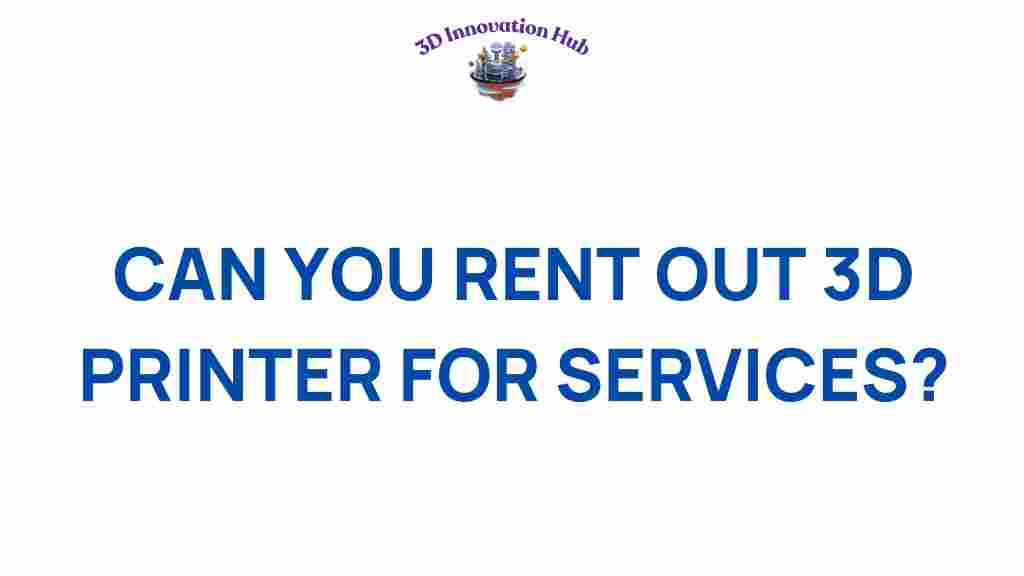Unlocking Opportunities: Can You Rent Out 3D Printers for Services?
In recent years, 3D printing technology has revolutionized various industries, offering immense potential for innovation and entrepreneurship. The rise of additive manufacturing has sparked a growing interest among individuals and businesses looking to leverage this technology. One intriguing avenue that has emerged is the concept of renting out 3D printers for services. This article explores the feasibility of this business model, how to get started, and the opportunities it presents.
The Evolution of 3D Printing and Additive Manufacturing
3D printing, also known as additive manufacturing, has come a long way since its inception. Initially limited to prototyping and industrial applications, this technology has evolved to serve various sectors, including healthcare, automotive, aerospace, and consumer goods. The accessibility of 3D printers has increased, making it possible for entrepreneurs to tap into this market.
Why Rent Out 3D Printers?
As a business model, renting out 3D printers offers several advantages:
- Lower Initial Investment: Instead of purchasing expensive 3D printers, entrepreneurs can start by renting them, reducing financial risk.
- Technology Access: Renting provides access to the latest 3D printing technology without the need for significant capital investment.
- Flexibility: Entrepreneurs can adjust their offerings based on demand, making it easier to pivot and innovate.
- On-Demand Printing: Businesses can offer on-demand printing services, catering to clients who need specific prototypes or products quickly.
How to Start a 3D Printing Rental Service
Starting a 3D printing rental service involves several steps to ensure success. Here’s a detailed guide to help you unlock opportunities in this burgeoning field:
1. Market Research
Understanding your target market is crucial. Conduct thorough research to identify:
- Potential customers (e.g., designers, engineers, hobbyists)
- Competitors and their offerings
- Pricing strategies and market demand
Utilize online resources and tools to gather data, and consider joining local makerspaces to connect with potential clients and gather insights.
2. Acquire Equipment
Once you’ve identified your market, it’s time to acquire the right 3D printers. Consider these factors:
- Printer Types: Determine which types of printers will best meet your customers’ needs (e.g., FDM, SLA, SLS).
- Quality and Reliability: Invest in high-quality machines to ensure customer satisfaction.
- Maintenance: Choose models that are easy to maintain and repair.
3. Set Up a Business Model
Your rental service can take several forms:
- Hourly Rental: Charge customers based on their usage time.
- Subscription Model: Offer monthly subscriptions for regular users.
- On-Demand Printing: Provide printing services where customers submit designs, and you print and deliver.
Evaluate which model aligns best with your target audience and operational capabilities.
4. Create an Online Presence
In today’s digital age, having a strong online presence is essential. Consider the following:
- Website: Create a user-friendly website showcasing your services, pricing, and contact information.
- Social Media: Utilize platforms like Instagram and Facebook to showcase your 3D printed products and engage with your audience.
- SEO Strategies: Implement SEO strategies to increase visibility. Use keywords such as “3D printing,” “rental services,” and “additive manufacturing” to attract potential customers.
5. Legal Considerations
Before launching your rental service, ensure you are compliant with local laws and regulations. Consider the following:
- Business Registration: Register your business and obtain necessary permits.
- Insurance: Invest in liability insurance to protect against potential damages or accidents.
- Rental Agreements: Draft clear rental agreements outlining terms and conditions.
6. Marketing Your Services
Once your business is set up, it’s time to attract customers. Use various marketing strategies:
- Networking: Attend local events, workshops, and maker fairs to connect with potential clients.
- Online Advertising: Utilize Google Ads and social media advertising to reach a broader audience.
- Collaborations: Partner with local businesses, schools, and design studios to offer special promotions.
7. Customer Support and Troubleshooting
Providing excellent customer support is vital for retaining clients and building a positive reputation. Consider the following:
- Offer tutorials and guides on how to use the printers effectively.
- Provide a dedicated support line for troubleshooting issues.
- Solicit feedback to continuously improve your services.
Troubleshooting Common Issues with 3D Printing Rental Services
As with any business, you may encounter challenges when running a 3D printing rental service. Here are some common issues and their solutions:
1. Printer Malfunctions
Printers can sometimes fail or experience malfunctions. To minimize downtime:
- Regularly maintain and calibrate your printers.
- Keep spare parts on hand for quick repairs.
- Provide customers with troubleshooting guides for common issues.
2. Customer Misunderstandings
Ensure customers fully understand the rental process:
- Provide clear instructions on how to operate the printers.
- Clearly outline rental terms and conditions to avoid confusion.
- Maintain open lines of communication for any questions or concerns.
3. Managing Inventory
Keep track of your equipment and materials to prevent shortages:
- Implement an inventory management system to track usage and availability.
- Regularly assess demand to adjust your fleet of printers accordingly.
- Maintain a stock of essential printing materials to ensure smooth operations.
Conclusion: Embracing the Future of 3D Printing Rental Services
The world of 3D printing is filled with opportunities for entrepreneurs willing to innovate and adapt. By renting out 3D printers, you can provide valuable services to a diverse clientele while minimizing initial investments and operational risks. This business model not only offers technology access to those who may not be able to afford their own equipment but also fosters creativity and innovation in various industries.
As you embark on this journey, remember to focus on customer satisfaction, stay updated on industry trends, and continuously seek ways to enhance your offerings. With the right approach, your 3D printing rental service can thrive, unlocking a world of possibilities for you and your clients. Start your adventure in additive manufacturing today!
For more insights into the evolving landscape of 3D printing and entrepreneurial strategies, visit this resource.
This article is in the category and created by 3D Innovation Hub Team
